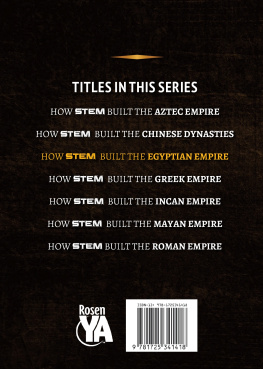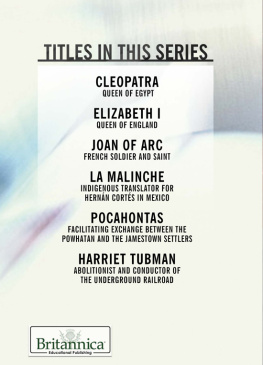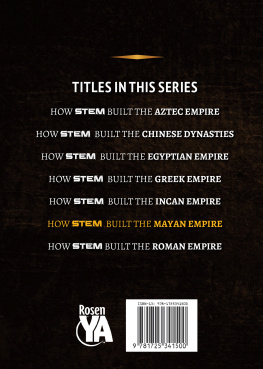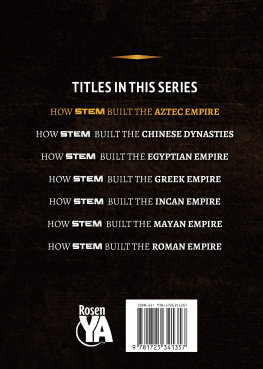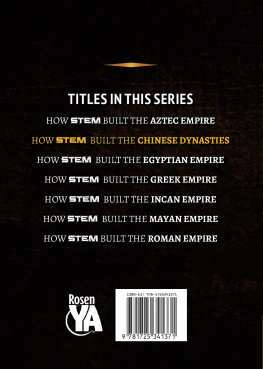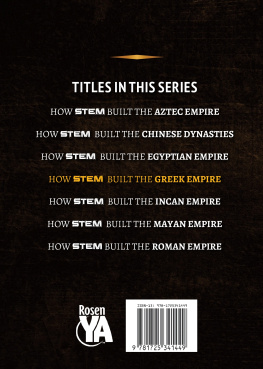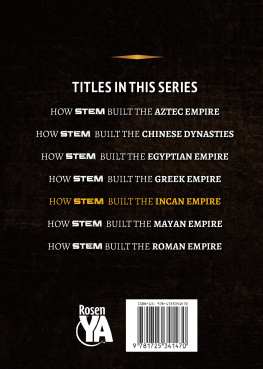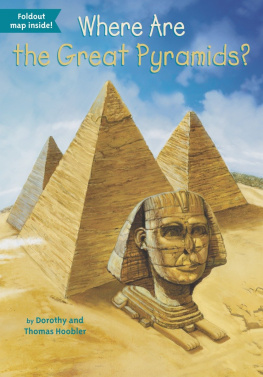
For my dad, who first instilled in me an interest in faraway times and places
Published in 2020 by The Rosen Publishing Group, Inc.
29 East 21st Street, New York, NY 10010
Copyright 2020 by The Rosen Publishing Group, Inc.
First Edition
All rights reserved. No part of this book may be reproduced in any form without permission in writing from the publisher, except by a reviewer.
Library of Congress Cataloging-in-Publication Data
Names: Uhl, Xina M., author.
Title: How STEM built the Egyptian empire / Xina M. Uhl. Description: New York: Rosen Publishing, 2020. | Series: How STEM built empires | Includes bibliographical references and index.
Identifiers: LCCN 2019013180| ISBN 9781725341418 (library bound) | ISBN 9781725341401 (pbk.)
Subjects: LCSH: TechnologyEgyptHistoryJuvenile literature. | ScienceEgyptHistoryJuvenile literature. Classification: LCC T16 .U45 2019 | DDC 609.32dc23 LC record available at https://lccn.loc.gov/2019013180
Manufactured in the United States of America
On the cover: Though Egypts pyramids are the countrys most iconic structures, the ancient culture developed countless other STEM innovations.
CONTENTS
INTRODUCTION
O ne of the worlds earliest civilizations, ancient Egypt left behind a dazzling array of evidence about its accomplishments and beliefs. Egypts long historyextending over thousands of yearssaw numerous changes in rulers, massive shifts in the size of the empire, and varying beliefs about divinity and the afterlife. Magic existed for the Egyptians, and the workings of the gods were never far from their minds. At the center of Egyptian life was the great Nile River, without which it would have been impossible to live in the hot, forbidding deserts of the region.
The grandeur of pyramids, fabulous riches, tomb paintings, and sculptures reveal Egyptian knowledge, life, practices, and culture so thatalong with written sourceshistorians can understand their achievements in science, technology, engineering, and mathematics (STEM).
Early science concerned itself with practical applications. Observations of the positions and movements of the stars and planets provided ancient Egyptians with information to make sense of time. By establishing calendars, farmers could predict the seasons and yearly events, such as the flooding of the Nile River. They divided time into weeks and invented water clocks and sundials to tell more precise time.
Technology and engineering combined in agriculture. A device called the shadoof transferred water from the Nile to individual farmers, while extensive irrigation systems brought water to thirsty crops in larger-scale efforts.
Mathematics allowed the Egyptians to measure the flooding of the Nile and calculate taxes during years of both lesser and greater floods since taxes were based on the famers crop yields.
Egyptians developed an independent form of writing, called hieroglyphics, which allowed them to record laws, history, letters, magic spells, and religious tales. Though the meaning of hieroglyphics was lost over the centuries since ancient Egypts decline, scholars in the early nineteenth century found a means of translating it.

The Nile River delta is home to many types of plant and animal life. In addition to reeds and water lettuce, fish and crocodiles are abundant.
Egyptian medicine was renowned throughout the ancient world for its ability to treat a variety of illnesses and conditions. Not only did the ancient Egyptians put a premium on cleanliness, but they also devised numerous medicines that helped their patientsin addition to some that either hurt or did not help.
Egyptians are well known for their concern with death. Their belief that dead bodies should be preserved led to the practice of mummification and to the construction of massive pyramids and temples. The scientific method behind mummification is fascinating, as is the technology and engineering necessary to quarry stone and make use of it in precise ways that enabled them to stand for millennia. In addition to pyramids, Egyptian temples displayed a level of detail and a mastery of construction techniques that have often astounded modern scholars.
Accomplished metallurgists and glassblowers, the Egyptians became skilled in creating decorative items that have impressed people across the ages. The treasures of King Tutankhamun display the sophisticated use of gold, jewels, alabaster, and other materials. All in all, ancient Egypt is a truly intriguing case study for those interested in the history and evolution of STEM.
CHAPTER ONE

THE BLACK LAND
W ithout the Nile River, Egyptian society would not have existed. The river provided water suitable for drinking, crops, and transportation, as well as being a natural habitat for countless birds, fish, turtles, frogs, hippos, crocodiles, gazelles, and plants such as lotus, papyrus, and date palms.
From south of the equator in Africa, the mighty Nile River begins its long journey northward. It travels for more than 4,000 miles (6,437 kilometers) through northeastern Africa, making it the worlds longest river. From the south of Africa, it flows north before eventually draining into the Mediterranean Sea. The delta area is known as Lower Egypt, the home of Giza, Saqqarah, and the onetime capital city Memphis. Southward lies the narrow river valley known as Upper Egypt, the location of Karnak and Thebes (todays Luxor). Still further south lies the land of Nubia. Six cataracts, or river waterfalls, divide the Nile here.

This 1826 map shows Upper Egypt in the south (pink), Lower Egypt in the north (green), and the delta (yellow) spilling out into the Mediterranean Sea. The spine of Egypt, the Nile, is the countrys central feature.
A HARSH LAND
Deserts make up the western and eastern edges of Egypt. Called the Red Land, the deserts were named after the tint of the earth there. Little grew in these areas, and the hot, forbidding sands served as a barrier against invading armies. Certain areas of the Red Land provided opportunities to mine or quarry for precious metals and jewels.
During its annual flooding, the Nile River deposited black silt on the riverbanks. The Egyptians called this fertile land the Black Land. Here, they grew crops. The Nile provided fish, birds, and wild plants to eat, along with water for cooking and bathing. The boats that sailed along the Nile also made the river Egypts main highway.
To the northeast, in todays countries of Iraq, Syria, and Turkey, lay Mesopotamia, another ancient culture that rose up at about the same time as ancient Egypt. Mesopotamia is a Greek word that means land between the two rivers. These two rivers are called the Tigris and the Euphrates, and they, too, deposited silt on the earth after floods. These rivers, however, created conditions different from those of the Nile. The flooding of the Nile happened every summer, and the floodwaters receded in the fall on a regular, predictable schedule. The amount of the flooding varied, but not so wildly as did the flooding of the Mesopotamian rivers, which arrived unpredictably and which often caused much destruction.
Mesopotamians did not enjoy the safety of the Egyptians. Because of their location between the two rivers, they found themselves at the crossroads of different warring peoples. Egypt lay mostly protected from such attacks by barren deserts. The safety and the abundance that Egyptians experienced influenced their outlook on life and death. To them, Egypt was a natural paradise.
Next page
